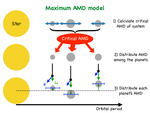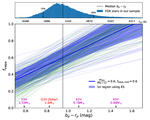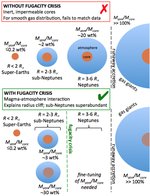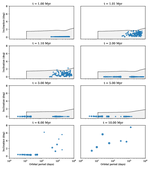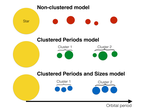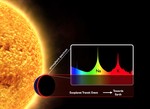The Occurrence of Rocky Habitable Zone Planets Around Solar-Like Stars from Kepler Data
We present occurrence rates for rocky planets in the habitable zones (HZ) of main-sequence dwarf stars based on the Kepler DR25 planet …
A Featureless Infrared Transmission Spectrum for the Super-puff Planet Kepler-79d
Extremely low-density planets (“super-puffs”) are a small but intriguing subset of the transiting planet population. With …
The Habitable Zone Planet Finder Reveals a High Mass and Low Obliquity for the Young Neptune K2-25b
Using radial velocity data from the Habitable Zone Planet Finder, we have measured the mass of the Neptune-sized planet K2-25b, as well …
The EXPRES Stellar-signals Project. I. Description of Data
The EXPRES Stellar-Signals Project is providing sets of high-fidelity, spectroscopic and photometric observations to enable direct …
A Warm Jupiter Transiting an M Dwarf: A TESS Single-transit Event Confirmed with the Habitable-zone Planet Finder
We confirm the planetary nature of a warm Jupiter transiting the early M dwarf TOI-1899 using a combination of available TESS …
TOI-1728b: The Habitable-zone Planet Finder Confirms a Warm Super-Neptune Orbiting an M-dwarf Host
We confirm the planetary nature of TOI-1728b using a combination of ground-based photometry, near-infrared Doppler velocimetry and …
Sensitivity Analyses of Exoplanet Occurrence Rates from Kepler and Gaia
We infer the number of planets per star as a function of orbital period and planet size using Kepler archival data products with …
Persistent Starspot Signals on M Dwarfs: Multiwavelength Doppler Observations with the Habitable-zone Planet Finder and Keck/HIRES
Young, rapidly rotating M dwarfs exhibit prominent starspots, which create quasiperiodic signals in their photometric and Doppler …
Evidence for He I 10830A Absorption during the Transit of a Warm Neptune around the M-dwarf GJ 3470 with the Habitable-zone Planet Finder
Understanding the dynamics and kinematics of outflowing atmospheres of hot and warm exoplanets is crucial to understanding the origins …
Architectures of Exoplanetary Systems. II: An Intrinsic Relation between Planetary System Occurrence and Spectral Type for Kepler's FGK Dwarfs
The Kepler mission observed thousands of transiting exoplanet candidates around hundreds of thousands of FGK dwarf stars. He, Ford, …
A Sub-Neptune-sized Planet Transiting the M2.5 Dwarf G 9-40: Validation with the Habitable-zone Planet Finder
We validate the discovery of a 2-Earth-radii sub-Neptune-sized planet around the nearby high-proper-motion M2.5 dwarf G 9-40 (EPIC …
Atmosphere Origins for Exoplanet Sub-Neptunes
Planets with 2 R_⊕ < R < 3 R_⊕ and orbital period <100 days are abundant; these sub-Neptune exoplanets are not well understood. For example, Kepler sub-Neptunes are likely to have deep magma oceans in contact with their atmospheres, but little is known about the effect of the magma on the atmosphere. Here we study this effect using a basic model, assuming that volatiles equilibrate with magma at T ∼ 3000 K. For our Fe-Mg-Si-O-H model system, we find that chemical reactions between the magma and the atmosphere and dissolution of volatiles into the magma are both important. Thus, magma matters. For H, most moles go into the magma, so the mass target for both H2 accretion and H2 loss models is weightier than is usually assumed. The known span of magma oxidation states can produce sub-Neptunes that have identical radius but with total volatile masses varying by 20-fold. Thus, planet radius is a proxy for atmospheric composition but not for total volatile content. This redox diversity degeneracy can be broken by measurements of atmosphere mean molecular weight. We emphasize H_2 supply by nebula gas, but also consider solid-derived H2O. We find that adding H_2O to Fe probably cannot make enough H_2 to explain sub-Neptune radii because >10^3 km thick outgassed atmospheres have high mean molecular weight. The …
The mass of the Mars-sized exoplanet Kepler-138 b from transit timing
Here we report the sizes and masses of three planets orbiting Kepler-138, a star much fainter and cooler than the Sun. We determine …
An Earth-Sized Planet in the Habitable Zone of a Cool Star
The diagram compares the planets of our inner solar system to Kepler-186, a five-planet star system about 500 light-years from Earth in …
Transit Timing Observations from Kepler. VI. Potentially Interesting Candidate Systems from Fourier-based Statistical Tests
Planets in Systems from NASA’s Kepler Mission The image above depicts multiple planet systems discovered by NASA’s Kepler …
Transit Timing Observations from Kepler. V. Transit Timing Variation Candidates in the First Sixteen Months from Polynomial Models
Out of hundreds of candidate planetary systems, scientists had previously verified six systems with multiple transiting planets. Now, …
Kepler-47: A Transiting Circumbinary Multiplanet System
Press Coverage Two planets ... Two stars: Nasa detects strange new solar system : Daily Mail, August 30, 2012 Tatooine Now: NASA Finds …
Transit Timing Observations from Kepler. IV. Confirmation of Four Multiple-planet Systems by Simple Physical Models
Planets in Systems from NASA’s Kepler Mission The image above depicts multiple planet systems discovered by NASA’s Kepler …
Transit Timing Observations from Kepler. II. Confirmation of Two Multiplanet Systems via a Non-parametric Correlation Analysis
Planets in Systems from NASA’s Kepler Mission The image above depicts multiple planet systems discovered by NASA’s Kepler …
Constraining the Planetary System of Fomalhaut Using High-resolution ALMA Observations
Zooming in on Fomalhaut This video sequence starts with a wide-field view of the sky around the star Fomalhaut in the constellation of …
Almost All of Kepler's Multiple-planet Candidates Are Planets
See also papers II , III & IV that led up to this paper.
Press Coverage NASA mission piles on the planets: MSNBC, January 26, 2012 …
Transit timing observations from Kepler - III. Confirmation of four multiple planet systems by a Fourier-domain study of anticorrelated transit timing variations
Planets in Systems from NASA’s Kepler Mission The image above depicts multiple planet systems discovered by NASA’s Kepler …
Transiting circumbinary planets Kepler-34 b and Kepler-35 b
Press Coverage Kepler Discovery Establishes New Class of Planetary System: NASA Press release, Jan 11, 2012. NASA's Kepler mission and …
Probing potassium in the atmosphere of HD 80606b with tunable filter transit spectrophotometry from the Gran Telescopio Canarias
When an exoplanet transits across the face of its host star atoms and gases in its atmosphere absorb some of the starlight at specific …
The Kepler-19 System: A Transiting 2.2 R $_⊕$ Planet and a Second Planet Detected via Transit Timing Variations
Press Coverage Hidden Worlds: Astronomers Find Invisible Planet 650 Light-Years Away: Time, September 9, 2011. Astronomers Discover …
Kepler-16: A Transiting Circumbinary Planet
Press Coverage Real-life 'Star Wars' planet seen: MSNBC, September 16, 2011 NASA Detects Planet Dancing With a Pair of Stars: New York …
A closely packed system of low-mass, low-density planets transiting Kepler-11
Press Coverage Scientists Discover Solar System With 6 Planets: AOL News, February 2, 2011 Sun-Like Star With Six Planets Is Found …
Retired A Stars and Their Companions. VI. A Pair of Interacting Exoplanet Pairs Around the Subgiants 24 Sextanis and HD 200964
Press Coverage Dance of the planets gets intimate: Discovery News.com, July 30, 2010. Dancing Around a Dying Star: Astrobiology …
Five Kepler Target Stars That Show Multiple Transiting Exoplanet Candidates
Press Coverage A Tidal Wave of Exoplanet Candidates: Sky & Telescope.com, June 17, 2010 NASA finds potential planetary bonanza: …
Kepler-9: A System of Multiple Planets Transiting a Sun-Like Star, Confirmed by Timing Variations
Press Coverage WUFT, August 30, 2010. Recipe for a planetary system: Inside Nova, August 27, 2010. Planet Hunters Bag Systems With …
The Transit Ingress and the Tilted Orbit of the Extraordinarily Eccentric Exoplanet HD 80606b
Press Coverage Storm Worlds: Alien Wind on National Geographic Channel, May 2010. WUFT. September 30, 2009. WCJB TV-20 (ABC …
Identifying the Rotation Rate and the Presence of Dynamic Weather on Extrasolar Earth-like Planets from Photometric Observations
Press Coverage Ocean Glints Could Reveal Alien Planets: Space.com, August 7, 2008 Twinkle, Twinkle, Alien Ocean: Astrobiology …
Characterization of extrasolar terrestrial planets from diurnal photometric variability
Press Coverage Earth from Afar: A Tiny Flickering Dot: Astrobiology News, February 27, 2002 Student sees way to get E.T.’s …
Dynamical instabilities and the formation of extrasolar planetary systems
Press Coverage Search for New Planets Yields Confusion: New York Times, March 2, 1999. The Chance of Finding Aliens: Sky & …

